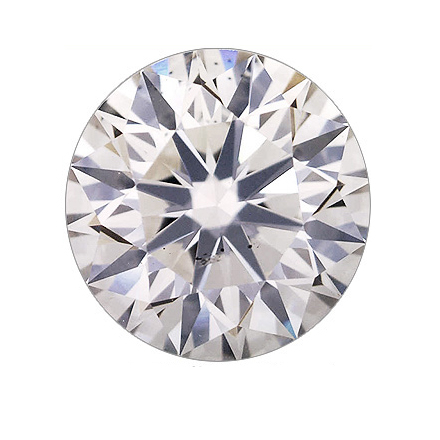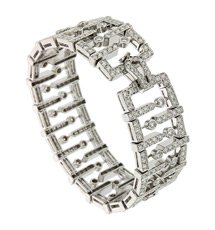Diamond Nesting
For diamonds to form in nature, they need the assistance of other rocks and minerals. Some provide the carbon needed to create the jewels, and others serve as a means of transport to bring diamonds to the earth’s surface. Still more stones serve as heralds, alerting explorers to the possibility of diamonds.
A side effect of so much company is that other materials may mix into the diamond’s crystal. Nitrogen atoms are common, though larger items may also appear in a diamond. Stones may end up inside the jewel, including other gems. Some are unusual enough to garner the attention of laboratories.
Gem phenomena occurs when light causes rare effects inside the stone, such as play of color, stars or a milk and honey effect. If certain trace elements mix into a gem’s crystal structure, its color will change depending on wavelengths in the light. In 2014, an Indian laboratory examined a diamond with a tiny stone imbedded on its surface. Under different lights, it showed green or purplish red. Specialized equipment revealed that the diamond’s companion was an unusual garnet.
Rubies encased in diamonds were recorded as early as 1645, though technology was not advanced enough to distinguish one red gemstone from another. It wasn’t until the early 1980s that the first ruby-in-diamond was confirmed. The gemstone lay close to the diamond’s surface, allowing easy reading from instruments such as microprobes and x-rays. The diamond’s provenance was unconfirmed, but likely occurred where geological conditions allow both jewels to form near one another.
Other unusual crystals include diamonds distinct from the jewel surrounding it. A New York lab examined a black diamond in 2015. Along with the usual quirks of black diamonds was a tiny octahedral diamond, embedded in a facet on the black jewel’s lower half. The gemologists studying this pair believe that the smaller jewel formed separately then traveled, getting caught in another stone’s creation.
Unique Diamond Inclusions
One of the standards by which diamonds are graded is their clarity. Flawless diamonds are extremely rare, and many jewels are plotted and cut to show as few inclusions as possible. Other gemstones are sought out precisely for their unusual characteristics. Designers may want stones for jewelry that stands out from others, or connoisseurs may want a diamond with subtle yet intriguing quirks.

Diamond rough with an unusual appearance which travels through the entire stone may be cut into slices. Cross sections may reveal growth marks from the jewel’s formation, like lines or concentric circles. Other patterns may resemble spider webbing or scales. Unlike with faceted diamonds, the more included the slice, the more in demand. These pieces may be set as pendants, earrings or other jewelry.
For diamonds that are cut normally, unique clarity characteristics can still catch the eye. Some inclusions are notable enough to be written about, such as one from a 2014 Gemological institute of America article. This diamond contained a crystal beneath its table facet with a narrow center and two broad ends, resembling a dumbbell. Other large and unusual recorded clarity characteristics include feather marks which resemble unicorns or starry clouds.
Many clarity characteristics are only visible under magnification. Their features can serve secret feature just for those in the know or look carefully. These can include tiny heart shapes, stick figures, or even spots of color. Hues may come from crystals within the diamond, or small amounts of natural radiation.
Where Diamonds Are Cut
While rough diamonds can be aesthetically pleasing, gem quality diamonds are in much greater demand if they’re cut. Diamond cutting often entails preserving as much weight as possible, adherence to proportion and drawing out a stone’s optical properties. Complications arise if the stone is especially large, small, fragile, or otherwise needs care to bring out its best qualities.
Regions with a large number of jewel manufacturers are known as cutting centers, and are able to process great quantities of rough, or those that require specific attention. Different locations known for certain specialties. Historical, cultural and other factors come together to influence how these centers operate, and the type of diamonds they concentrate on.
India is closely associated with diamonds. For centuries, it was the world’s primary source of rough stones. During the late 20th century, it was known for the large quantities of diamonds it processed. At the time, Australia’s Argyle diamond mine was producing large amounts of small, difficult to cut jewels. India had the technology and labor force needed to facet these gemstones. Though the country has since branched out into other aspects of diamond cutting, it’s still known for its skillful cutting of tiny diamonds.
In New York City’s Midtown area along 47th street is the Diamond District. The area is home to thousands of gemstone and jewelry firms as well as the Diamond Dealer’s Club, which serves as a de facto diamond exchange. Cutters in the city concentrate on processing large quality stones of high quality, which in turn are mounted onto high end jewelry.
Antwerp, Belgium has served as a center for diamond cutting and trading since the Middle Ages. One such cutter from the 1400s invented a polishing wheel capable of processing diamonds, allowing for complex faceting. In the 1940s, much of its dominantly Jewish workforce fled to other regions, contributing their expertise to other diamond centers. Today, Antwerp cutters are made of many ethnicities, who concentrate on cutting larger diamonds.
China’s growing prosperity has increased demand for luxury items such as jewelry. The 1980s saw a rise in the number of diamond polishers, which grew exponentially a decade later. As of 201, China processed over 15% of the world’s rough. The country focuses on creating small round diamonds as well as modest sized princess cuts. The industry is supported by the government in hopes of giving China greater recognition as a cutting center.
In countries where diamonds or other jewels are mined, a portion of the gems are set aside to support the country’s residents. This is known as beneficiation. It often takes the form of training local workers in other aspects of the industry, such as sorting, polishing or cutting diamonds. Nations such as Canada, Botswana and Namibia partner with diamond companies to improve their economies.





